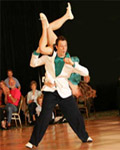
The word Ballroom dance is derived from the word ball.
Definition :The definition of ballroom dance also depends on the era. Balls have featured Minuet, Quadrille, Polonaise, Pas de Gras, Mazurka, and other trendy dances of the day, which are deemed to be historical dances.
Reference :Ballroom dance refers as a group to a set of partner dances, which instigated in the Western world and are now enjoyed both publicly and competitively around the globe. Its performance and entertainment facets are also broadly enjoyed on stage, in dance film, and on television. It is for young and old.
During the 20th century these dances came to be performed broadly in competitions, which thrived in Britain and America following the First World War. In 1929 the Official Board of Ballroom Dancing was found and by the 1930s consistency of training and levels of know-how expertise had been established. As most men are right handed dancers, it was conventional to wear the sword and scabbard on the left hand side of the belt, to facilitate the drawing of the sword with the right hand. It is hard to draw a sword with the right hand with the scabbard on the right. Thus if a man was to put his arm around a lady is back,she would have to be on his right, or she would keep tripping over the sword dance.








